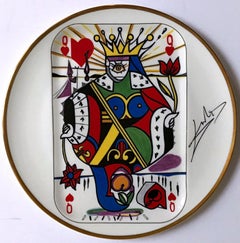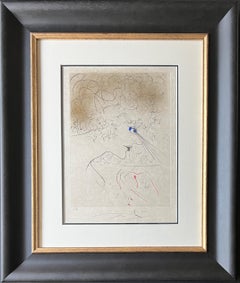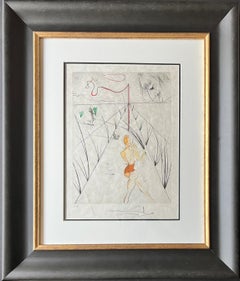Salvador Dalí Mixed Media
Instantly recognizable by his waxed, upturned mustache, the flamboyant Salvador Dalí is one of modern art’s most distinctive figures. He is also one of the icons of the 20-century avant-garde Surrealist movement, whose dreamlike images, drawn from the depths of the unconscious, he deployed in paintings, sculptures, prints and fashion, as well as in film collaborations with Luis Buñuel and Alfred Hitchcock.
Dalí was born in Figueres, Catalonia, and even as a youngster, displayed the sensitivity, sharp perception and vivid imagination that would later define his artworks. In these, he conjured childhood memories and employed religious symbols and Freudian imagery like staircases, keys and dripping candles to create unexpected, often shocking pieces.
Dalí's use of hyperrealism in conveying Surrealist symbols and concepts that subvert accepted notions of reality is epitomized in what is perhaps his most recognizable painting, The Persistence of Memory (1931), in which he depicts the fluidity of time through melting clocks, their forms inspired by Camembert cheese melting in the sun. His artistic genius, eccentric personality and eternal quest for fame made him a global celebrity.
“Each morning when I awake, I experience again a supreme pleasure,” he once said. “That of being Salvador Dalí.”
Find original Salvador Dalí paintings, prints, sculptures and other works on 1stDibs.
Mid-20th Century Surrealist Salvador Dalí Mixed Media
Ceramic, Screen, Porcelain
1960s Surrealist Salvador Dalí Mixed Media
Porcelain, Mixed Media, Archival Paper, Screen
1960s Surrealist Salvador Dalí Mixed Media
Watercolor, Etching, Drypoint, Paper
1960s Surrealist Salvador Dalí Mixed Media
Paper, Watercolor, Drypoint, Etching
1980s Surrealist Salvador Dalí Mixed Media
Paper, Screen
Mid-20th Century Surrealist Salvador Dalí Mixed Media
Screen
1970s Surrealist Salvador Dalí Mixed Media
Drypoint, Etching, Lithograph
21st Century and Contemporary Contemporary Salvador Dalí Mixed Media
Screen
1970s Surrealist Salvador Dalí Mixed Media
Drypoint, Aquatint
1970s Surrealist Salvador Dalí Mixed Media
Drypoint, Paper, Aquatint
1960s Surrealist Salvador Dalí Mixed Media
Archival Paper, Etching, Aquatint
1940s Surrealist Salvador Dalí Mixed Media
Drypoint, Etching
1970s Surrealist Salvador Dalí Mixed Media
Ink, Archival Paper, Aquatint
1960s Surrealist Salvador Dalí Mixed Media
Drypoint, Watercolor
1970s Surrealist Salvador Dalí Mixed Media
Drypoint, Aquatint
2010s Abstract Geometric Salvador Dalí Mixed Media
Archival Pigment
1960s Surrealist Salvador Dalí Mixed Media
Paper, Watercolor, Drypoint, Etching
20th Century Post-Impressionist Salvador Dalí Mixed Media
Gouache, Photographic Paper
1970s Surrealist Salvador Dalí Mixed Media
Paper, Etching, Stencil
1960s Surrealist Salvador Dalí Mixed Media
Paper, Mixed Media, Drypoint, Etching
1960s Surrealist Salvador Dalí Mixed Media
Drypoint, Etching, Paper, Watercolor
1960s Surrealist Salvador Dalí Mixed Media
Paper, Watercolor, Drypoint, Etching
1960s Surrealist Salvador Dalí Mixed Media
Paper, Watercolor, Drypoint, Etching
1960s Surrealist Salvador Dalí Mixed Media
Paper, Watercolor, Drypoint, Etching
1960s Surrealist Salvador Dalí Mixed Media
Paper, Watercolor, Drypoint, Etching
1960s Surrealist Salvador Dalí Mixed Media
Paper, Watercolor, Drypoint, Etching
1960s Surrealist Salvador Dalí Mixed Media
Paper, Watercolor, Drypoint, Etching
20th Century Post-Impressionist Salvador Dalí Mixed Media
Gouache, Photographic Paper
Salvador Dalí mixed media for sale on 1stDibs.
Artists Similar to Salvador Dalí
- 1stDibs ExpertApril 5, 2022Yes, Salvador Dali did create jewelry. Dali liked to explore different art mediums and jewelry definitely caught his fancy at one point in his life. His jewelry pieces were works of art in themselves and not mass produced—it was more like wearable miniature art. On 1stDibs, find a variety of original artwork from top artists.
- 1stDibs ExpertApril 5, 2022Yes, Salvador Dalí made sculptures. Salvador Dalí was known for his work in Surrealism and his work spans a multitude of repertoires including painting, graphic art, film, photography and sculpture. Some of Salvador Dalí’s most famous sculptures include Lobster Telephone and Mae West Lips Sofa. Shop a selection of Salvador Dali art on 1stDibs.
- 1stDibs ExpertApril 5, 2022After Dali was forced into involuntary retirement, fake prints flooded the market. Very few of Dali’s works were signed after 1980. Arjomari paper, the paper on which Dali worked, changed their mark by adding an infinity symbol. So if you see the infinity symbol and Dali’s signature, the print is a fake. On 1stDibs, find a collection of Salvador Dali’s pieces from some of the world’s top sellers.






